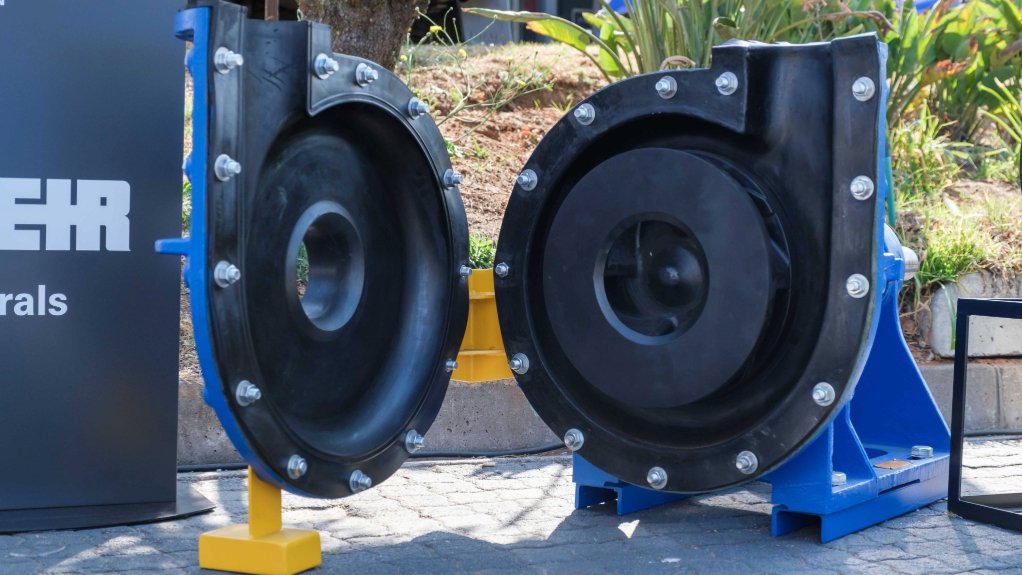Rubber linings resist coarse particle abrasion in pumps






Marnus Koorts, General Manager for Pump Products at Weir
Weir has found that customers can save significantly on components and maintenance downtime with rubber linings
Rubber is very good at absorbing and transferring energy, making it ideal for larger mill pumps
Weir’s customers can gain from the lower carbon footprint associated with rubber linings
Weir has spent decades developing elastomer technology and has its own in-house laboratory for this purpose
This article has been supplied.
Weir has found that its customers dealing with large particle abrasion in their pumps can save significantly on components and maintenance downtime by using rubber linings.
According to Marnus Koorts, General Manager for Pump Products at Weir, these linings excel in applications where particles are being driven by a great deal of energy.
“Rubber is very good at absorbing and transferring the energy from moving particles , whereas metal liners are more readily worn away by those impacts,” says Koorts. “This makes rubber linings ideal on the larger mill pumps and similar applications, which is where our customers get optimal value from this solution.”
He notes that Weir has spent decades developing its elastomer technology and trialling it in the field, giving it considerable advantage over competitors – many of whom have only recently begun introducing rubber lining on their pumps.
“We have helped customers to deal with some of the most abrasive applications to be found in mining. These conditions are commonly found where hard rock is mined, crushed, and milled, and the coarse particles leave the mill to be pumped further,” he says. “Among our case studies are installations where the pump’s wear life was improved significantly after it was lined with rubber.”
Another benefit of using rubber in these large pumps is that it is relatively lightweight compared to unlined metal pumps, enhancing safety and easing maintenance of rubber parts.
“A mill pump is a mission-critical item of equipment, so maintenance really needs to be as fast and infrequent as possible,” emphasises Koorts. “The whole plant process often comes to a halt when the mill stops if there is no standby pump, what we call a Service Class 5 pump.”
Replacing a rubber lining on a pump can be done quickly, and less often – giving the plant optimal uptime. He points out that this also provides a higher level of safety against the risk of particle wear actually breaking through the shell of the pump. In cases where these incidents have occurred, the high pressure inside the pump can spray slurry up to a couple of hundred metres – presenting considerable safety and environmental hazards.
“Where the rubber lining is present, it is encapsulated by a metal shell for added support,” he says. “Maintenance planning can be enhanced by using Weir’s Synertrex wear monitoring technology, which would alert the operators to the need for parts replacement, avoiding failures.”
He highlights that many of Weir’s pump ranges are available with the option of either rubber or metal liners. This has allowed many customers to easily trial the rubber lined option, as this can be done through a simple swap-in process during the plant’s shutdown period.
“We’ve seen a definite shift in the mining industry towards rubber lining on pumps, as mines recognise their value in these applications,” he concludes. “This is also a time when mining companies are starting to consider their upstream and downstream carbon impact. They can gain from the lower carbon footprint associated with rubber linings compared with steel.”
Weir Minerals Africa
Article Enquiry
Email Article
Save Article
Feedback
To advertise email advertising@creamermedia.co.za or click here
Press Office
Announcements
What's On
Subscribe to improve your user experience...
Option 1 (equivalent of R125 a month):
Receive a weekly copy of Creamer Media's Engineering News & Mining Weekly magazine
(print copy for those in South Africa and e-magazine for those outside of South Africa)
Receive daily email newsletters
Access to full search results
Access archive of magazine back copies
Access to Projects in Progress
Access to ONE Research Report of your choice in PDF format
Option 2 (equivalent of R375 a month):
All benefits from Option 1
PLUS
Access to Creamer Media's Research Channel Africa for ALL Research Reports, in PDF format, on various industrial and mining sectors
including Electricity; Water; Energy Transition; Hydrogen; Roads, Rail and Ports; Coal; Gold; Platinum; Battery Metals; etc.
Already a subscriber?
Forgotten your password?
Receive weekly copy of Creamer Media's Engineering News & Mining Weekly magazine (print copy for those in South Africa and e-magazine for those outside of South Africa)
➕
Recieve daily email newsletters
➕
Access to full search results
➕
Access archive of magazine back copies
➕
Access to Projects in Progress
➕
Access to ONE Research Report of your choice in PDF format
RESEARCH CHANNEL AFRICA
R4500 (equivalent of R375 a month)
SUBSCRIBEAll benefits from Option 1
➕
Access to Creamer Media's Research Channel Africa for ALL Research Reports on various industrial and mining sectors, in PDF format, including on:
Electricity
➕
Water
➕
Energy Transition
➕
Hydrogen
➕
Roads, Rail and Ports
➕
Coal
➕
Gold
➕
Platinum
➕
Battery Metals
➕
etc.
Receive all benefits from Option 1 or Option 2 delivered to numerous people at your company
➕
Multiple User names and Passwords for simultaneous log-ins
➕
Intranet integration access to all in your organisation























